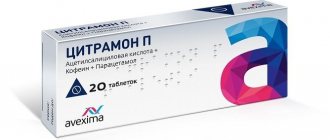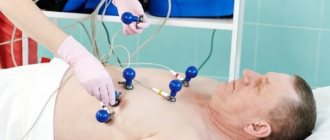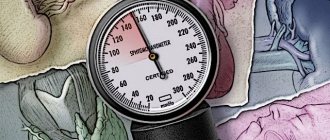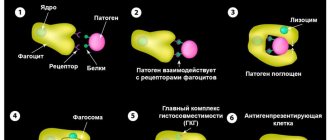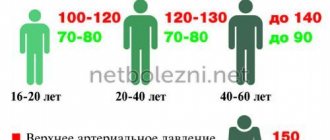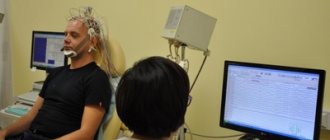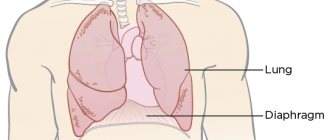What is low blood pressure anyway?
Blood pressure is the force with which blood pushes against the walls of the arteries. At the moment when the heart contracts, the pressure is highest - it is called upper, or systolic. In the interval between heartbeats, the pressure in the vessels drops - it is called lower, or diastolic.
Normal blood pressure ranges from 90/60 to 120/80 mmHg. The numbers 90 and 120 indicate systolic pressure, and 60 and 80 indicate diastolic pressure. If the readings are less than 90/60, the blood pressure is considered low. This condition is called hypotension.
Features of treatment
A physiological decrease in pressure does not require any additional measures. It is enough to spend more time in the fresh air, get enough sleep, and stimulate the myocardium with strong tea or coffee.
Urgent measures
A sharp drop in blood pressure requires emergency measures:
- the patient is laid horizontally, his legs are raised (to prevent aspiration of possible vomit, his head is on one side);
- they call an ambulance and find out if the patient has diabetes;
- take off tight clothes, open windows;
- give a swab with ammonia to sniff;
- in the absence of diabetes, give hot, sweet, strong tea;
- rub the earlobes;
- warms the extremities.
You should not give cold water, alcohol, coffee or medications, and allow you to get up immediately after the attack has stopped. This will only make the suffering worse. You must wait until the ambulance arrives to transfer the patient from hand to hand.
Medications
Any accidental drop in blood pressure below a critical level (reading less than 80/60) can lead to death. Therefore, when prescribing medications, it is necessary to ensure that there are no contraindications to their use, that is, to clarify the concomitant pathology. If there are no restrictions, we recommend:
| Group of drugs | Individual representatives |
| Preparations with caffeine: relieve headaches, including migraine type (preparations containing caffeine are sold in pharmacies only with a doctor’s prescription; over-the-counter forms do not contain caffeine) | Algon, Acepar, Pentalgin-N, Citramon, Askofen, Pyramein, Coficil, Migrenol |
| Respiratory analeptics: stimulate the respiratory center, relieve fear, anxiety, insomnia | Cordiamine, Sodium benzoate, Camphor, Bemegride, Corazol |
| Hypertensive drugs: raise blood pressure, increase myocardial contractility | Acrinor, Angiotensinamide, Isoturon, Regulton, Remestip |
| Amino acids: strengthen the cell membrane, optimize the passage of ions and nutrients through it, improving the activity of cells in many organs and systems | Ortho-taurine, Citrulline |
| Nootropics: improve cerebral circulation and metabolic processes | Noopept, Glycine, Nootropil, Piracetam, Cinnarizine, Encephabol |
| Angioprotectors: improve blood flow, strengthen the walls of blood vessels, as side effects - relieve ringing in the ears, normalize sleep, memory | Tanakan, Detralex, Ascorutin, Phlebodia, Troxevasin |
| Vitamin complexes | Unicap, Enerion, Glutamevit, Complivit, Centrum |
All medications are taken in courses according to individual regimens drawn up by a doctor after all provoking factors have been eliminated.
Folk remedies
Comprehensive treatment of low blood pressure in men involves the use of traditional medicine produced in pharmacies and home-made. The most popular pharmacy fees are:
- herbs wormwood, chamomile, tartar, lemon balm with angelica roots, rose hips;
- a collection of wormwood, immortelle, lemongrass shoots, viburnum, aralia, valerian root;
- rose hips, hawthorn, viburnum, tansy seeds, oats, mint leaves, celandine.
Taking the preparations is possible only after consultation with a doctor, who will calculate the dosage of the drug. Otherwise, the herbs may become dangerous.
Quick helpers:
- salt (a pinch of salt or something salty with black bread);
- coffee or a cup of strong tea;
- a glass of sweet soda, a handful of mulberries or red grapes;
- pomegranate: be careful with stomach problems(!)
Prepare the following products yourself:
- Chinese lemongrass (15g) is poured with a glass of boiling water and cooked over low heat (without boiling!) for 15 minutes. Let the broth cool, drink a tablespoon three times a day;
- freshly squeezed lingonberry juice (one and a half glasses) is drunk in three doses, for a course of 10 days;
- Celery juice is taken one tablespoon three times a day;
- three pureed lemons are poured with cold water (half a liter), left in the refrigerator for 30 hours, a glass of honey is added, put in the refrigerator again for 30 hours, taken half an hour before meals, three times a day, a tablespoon;
- brew equal proportions of St. John's wort, lemongrass, tartar, ephedra, tansy with boiling water, infuse, cool, take by spoon three times a day.
- How they drink tea: rosehip, lemon balm, lemongrass.
- juices: carrot, beet, grape, mix with parsley - all freshly squeezed, course - a month.
Culinary recipes:
- dietary supplement to the basic diet from a mixture of cottage cheese, dried apricots, raisins, pomegranate;
- a mixture of white and black raisins, dried apricots, walnuts with 3 tablespoons of honey, drink by spoon before meals;
- a glass of boiled beans or beans is fried in vegetable oil along with a few cloves of garlic (cautious for patients with digestive problems) - a ready-made second course.
For hypotension in men, the following have proven effective:
- massage;
- physiotherapy;
- acupuncture;
- aromatherapy;
- balneotherapy.
Provided there is no discomfort for the patient, their lifestyle is adjusted:
- patients get used to not getting out of bed abruptly, do morning exercises, squeezing and unclenching their fingers (we wrote, we wrote, our fingers were tired - this tones the smallest capillaries);
- A hearty breakfast is required;
- normal drinking regime;
- avoid overheating and hypothermia;
- carry out anti-stress training;
- shows walks at night and a restful 8-hour sleep, giving up any bad habits.
At any age, if you have problems with blood pressure, you should consult a doctor. Early detection of pathology increases the chance of recovery several times.
Is low blood pressure dangerous?
Many people - most often thin women - live with hypotension for years and feel great. Doctors believe that these people are lucky: they are less likely to suffer from cardiovascular diseases.
However, if your blood pressure suddenly drops below normal levels, unpleasant symptoms may appear:
- blurred vision;
- dizziness;
- fainting;
- nausea or vomiting;
- drowsiness;
- feeling of weakness.
As a rule, at a young age, the health risk is associated not with low blood pressure itself, but with the reasons due to which it falls. The exception is fainting. “This is the most alarming symptom, since it often leads to injuries and accidents,” says Oksana Dikur, general practitioner, cardiologist at the Rassvet clinic. “If hypotension is accompanied by loss of consciousness, you should definitely consult a doctor.”
But for older people, low blood pressure can be really dangerous. Moreover, a drop in diastolic pressure is more dangerous than a decrease in systolic pressure.
“This can lead to deterioration of blood supply to the kidneys and brain, increasing the risk of stroke and kidney failure,” explains Oksana Dikur.
How to Diagnose the Problem
There is a standard algorithm for examining a hypotensive patient who has sought medical help for the first time:
- UAC, OAM;
- blood sugar test;
- hormone testing;
- cardiac ultrasound;
- ECG;
- Doppler ultrasound of the vessels of the brain and cervical spine.
Then, any somatic pathology should be excluded. Here they pay attention to the conditions of the patient’s professional activity, his habits, and heredity. Daily tonometry is performed on both arms (morning and evening).
What causes hypotension?
If you suddenly change your body position
Get up quickly or, for example, sit up sharply in bed. This is called orthostatic hypotension. When a person assumes a vertical position, blood, under the influence of gravity, rushes to the legs and abdominal area, and the pressure in the vessels drops. In order to raise blood from the legs and normalize blood pressure, the autonomic nervous system increases the heart rate and constricts blood vessels.
Healthy people do not experience discomfort, since this mechanism works very quickly. But in some cases, the autonomic nervous system fails. As a result, the pressure drops, the blood does not have time to rise from the legs, the brain lacks oxygen, and symptoms of hypotension appear. This happens, for example, in pregnant women, in people with certain diseases such as diabetes, and in every fifth elderly person.
Sometimes healthy people experience similar sensations, for example due to heat, and there is nothing to worry about. But if you feel dizzy every time you change position, you need to see a doctor.
If you eat
After eating, blood rushes to the gastrointestinal tract, and to prevent pressure from dropping too much, the autonomic nervous system constricts blood vessels and increases the heart rate. However, in about a third of older people it cannot cope with such a load. This condition is called postprandial hypotension. If this happens, you need the help of a doctor.
If you grow too fast
As you might guess, the problem most often occurs in children and adolescents: due to rapid growth, a malfunction occurs in the functioning of the autonomic nervous system. As a result, when you change your posture or bend over, symptoms such as dizziness and fainting appear. This is called nerve-mediated hypotension. Children usually outgrow the problem, and hypotension goes away on its own.
But sometimes neurally mediated hypotension is a sign of serious neurological diseases. In this case, the person needs the help of a doctor.
If you get sick
Blood pressure may drop in people who are dehydrated, those who have had shock, diabetics, and patients with arrhythmias and heart failure. In this situation, doctors seek to cure or control the disease that is causing hypotension.
If you take certain medications
Sometimes hypotension is a side effect of anti-anxiety medications, diuretics, painkillers, or blood pressure pills. In order to solve the problem, it is usually enough for the doctor to adjust the dose of the medication.
Clinical manifestations
Hypotension can be a single disease or a sign of another disease. We can talk about hypotension as a pathological condition if:
- the systolic indicator does not rise above 100, and the diastolic indicator does not rise above 65 for a long time;
- the first manifestations of the disease at an early age.
Symptoms of low blood pressure in women:
- People, in particular women, suffering from constant low blood pressure have pale, cold skin. Under the influence of hypoxia, blue or brown circles appear under the eyes. If the cause of hypotension is hypothyroidism, then the skin is dry and pale;
- With hypotension, the nervous system also suffers greatly. The patient suffers from chronic fatigue and lack of sleep. Even a long sleep during the night does not restore her strength, and after waking up she feels extremely weak. If the disease occurs against the background of endocrine problems, inhibition and deterioration in learning and memory are possible.
- The woman feels unwell depending on the weather conditions.
- Possible coldness of the extremities.
- The respiratory system also suffers from hypotension. The lungs react with shortness of breath even with slight exertion. As a result, the tissue does not receive the necessary oxygen supply.
- Often the cause of the disease is adherence to a strict diet. Vegetarianism and not eating enough essential nutrients are common causes of hypotension.
- A lack of iron, in other words, anemia, can lower blood pressure in a mature woman. It occurs as a result of a complete refusal to eat meat products and not replacing necessary substances with iron supplements. Anemia is also possible with uterine fibroids or hemorrhoids.
Hypotension may be a consequence of vegetative-vascular dystonia, a condition that requires monitoring by specialists.
